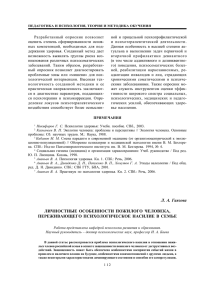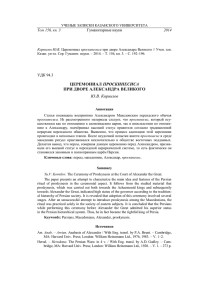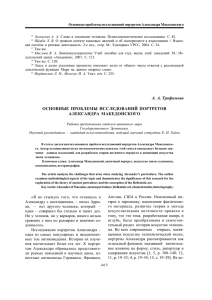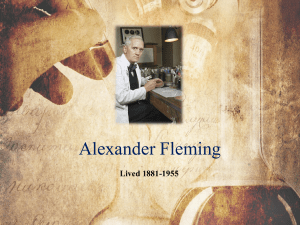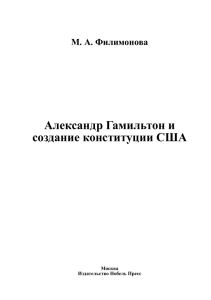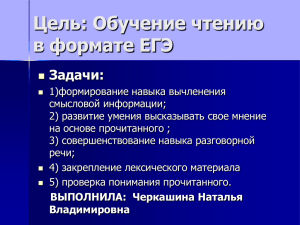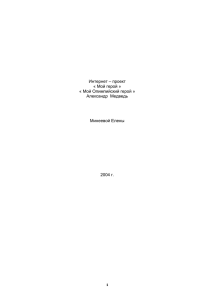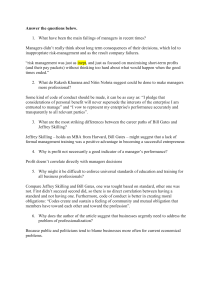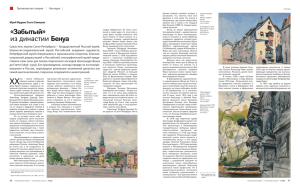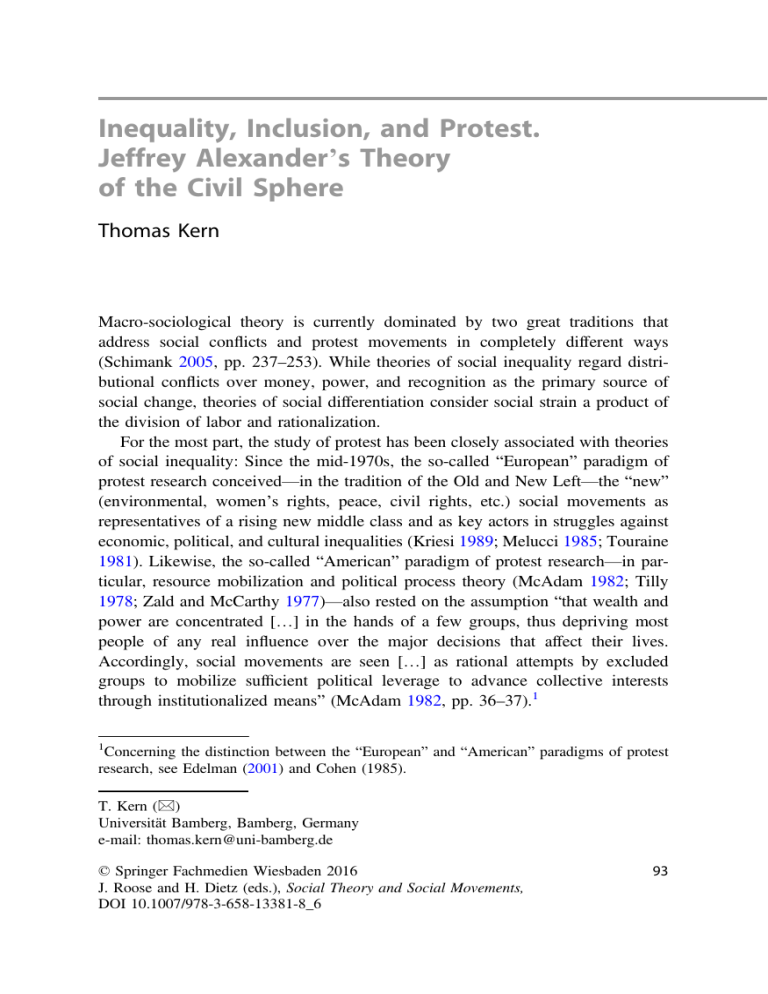
Inequality, Inclusion, and Protest. Jeffrey Alexander’s Theory of the Civil Sphere Thomas Kern Macro-sociological theory is currently dominated by two great traditions that address social conflicts and protest movements in completely different ways (Schimank 2005, pp. 237–253). While theories of social inequality regard distributional conflicts over money, power, and recognition as the primary source of social change, theories of social differentiation consider social strain a product of the division of labor and rationalization. For the most part, the study of protest has been closely associated with theories of social inequality: Since the mid-1970s, the so-called “European” paradigm of protest research conceived—in the tradition of the Old and New Left—the “new” (environmental, women’s rights, peace, civil rights, etc.) social movements as representatives of a rising new middle class and as key actors in struggles against economic, political, and cultural inequalities (Kriesi 1989; Melucci 1985; Touraine 1981). Likewise, the so-called “American” paradigm of protest research—in particular, resource mobilization and political process theory (McAdam 1982; Tilly 1978; Zald and McCarthy 1977)—also rested on the assumption “that wealth and power are concentrated […] in the hands of a few groups, thus depriving most people of any real influence over the major decisions that affect their lives. Accordingly, social movements are seen […] as rational attempts by excluded groups to mobilize sufficient political leverage to advance collective interests through institutionalized means” (McAdam 1982, pp. 36–37).1 Concerning the distinction between the “European” and “American” paradigms of protest research, see Edelman (2001) and Cohen (1985). 1 T. Kern (&) Universität Bamberg, Bamberg, Germany e-mail: [email protected] © Springer Fachmedien Wiesbaden 2016 J. Roose and H. Dietz (eds.), Social Theory and Social Movements, DOI 10.1007/978-3-658-13381-8_6 93 94 T. Kern In contrast to this intellectual position, theories of differentiation have shown only weak interest in the development of social movements and conflicts (see also Kusche in this volume). For many years, problems of social inequality have not been at the top of the agenda. Under the hegemony of structural functionalism, the rise of social movements was usually associated with rapid social change, economic crises, and deficits of social integration. From this point of view, revolutions, unrest, and protests indicate a breakdown of social control (Davies 1962; Gurr 1974). Researchers have conceived of protest movements not as purposeful collectivities, but as unorganized masses of frustrated, alienated, and uprooted “losers” to modernization. Supposedly spontaneous and irrational outbreaks of collective violence have been regarded as a psychological response to social anomie and strains. Therefore, many students have considered social movements as a part of the problem rather than a part of the solution (Smelser 1962). However, in the 1980s, the so-called neofunctionalist movement developed a great interest in the relationship between social movements and structural differentiation (Pettenkofer 2010, pp. 107–127; Alexander 1985; Alexander and Colomy 1990). The neofunctionalists conceived of structural differentiation as a contentious process driven by economic, political, and cultural interests. Subsequently, the concept of social movement shifted to the center of neofunctional analysis. This discourse was strongly shaped by a young intellectual named Jeffrey Alexander. In the 1990s, he took the discussion further and developed a comprehensive theory of the civil sphere that puts great emphasis on social movements and attempts to build bridges between the two great traditions of sociological theory. He conceives of the civil sphere, on the one hand, as an analytically differentiated social realm beside the so-called “non-civil” spheres such as economy, politics, law, science, and religion. The discursive structure of this civil sphere is, on the other hand, shaped by the “ideal of a horizontal relationship, of a broad and universalizing solidarity […] that makes every form of domination fundamentally unstable and every unequal distribution contestable” (Alexander 2007b, pp. 25–26). The civil sphere constitutes a relatively independent realm of discourse and contention about economic, political, and cultural inequality.2 In this way, Alexander provides a At first glance, this approach closely resembles Habermas’ distinction between system and lifeworld (Habermas 1987, 1996; Cohen and Arato 1992). However, Alexander strongly objects to the notion that “civil society is a world of rationality and consensus.” He demands the recognition of “the unconscious and nonrational elements […] that structure civil societies to be placed within the meaning-making process of civil discourse itself rather than forcing them into residual categories that are projected onto the noninterpretative domains outside it” (Alexander 1993, p. 801). 2 Inequality, Inclusion, and Protest 95 comprehensive macro-sociological framework for the analysis of social movements. This article aims to highlight the central elements of Alexander’s theory of the civil sphere with special emphasis on the relationship between structural differentiation and social movements. In the first part, I will focus on the transition from functionalism to neofunctionalism in differentiation theory. In the second part, I will examine the institutional framework and the cultural codes of the civil sphere. In the third part, I will shift my attention to the boundary relations of the civil sphere and the role of social movements. 1 From Functionalism to Neofunctionalism In the 1950s and 1960s, the sociological debate was largely dominated by the structural functionalist theory of Talcott Parsons. Parsons understood history as an evolutionary process in which the societal capacities of solving problems are continually enhanced. From his point of view, the social system is continuously affected by random variations, leading to more efficient solutions in coping with the environment of a society. As a consequence, the adaptive capacities of the social system continuously increase and enable it to realize higher levels of structural complexity. Parsons conceived of functional differentiation as the key to increasing the complexity of society: Every time a given social system fails to solve a specific problem, the pressures toward structural differentiation grow. Consequently, the more society advances on this developmental path, the greater its capacity to solve problems. Considering that limits of performance stimulate the development of new (“superior”) institutions, the concept of structural differentiation is in this stage inextricably linked to the idea of social progress. However, Parsons largely ignored the existence of permanent tensions between normative ideals and institutional reality. He also remained silent about the unequal distribution of benefits and costs in the process of differentiation (Rueschemeyer 1977). His optimistic conclusion was diametrically opposed to the history of violence in the 20th century. Likewise, his idealization of the United States as an “almost perfect blend of social integration and social justice” (Alexander 2005, p. 98)—despite the continual social exclusion of many U.S. ethnic groups—not only met with the resistance of his opponents, but it also stimulated criticism among his sympathizers. 96 T. Kern At this point, the neofunctionalists—including Alexander—began to reconstruct and reinterpret the work of Parsons. The neofunctionalists constituted a group of sociologists who sought “to broaden functionalism’s intellectual scope while retaining its theoretical core” (Alexander and Colomy 1985, p. 11). However, as some critical observers have pointed out, the heterogeneity of this group was so great that it sometimes appeared difficult to identify a common denominator (Joas 1988). Despite this problem, at least for the inner circle around Alexander, the concept of neofunctionalism is characterized by focusing on social phenomena in analytical levels (culture, structure, and personality); social systems and subsystems, as well as their interchanges; normative processes; differentiation dynamics; and differentiated substructures (Turner and Maryanski 1988, p. 118). Although the neofunctionalists preserved the substance of the Parsonian action scheme, they refused to explain social change in functional terms of need states and social requisites. Instead, their attention shifted from the (functional) consequences to the (historical) causes of structural differentiation.3 They distanced themselves from Parsons’ linear concept of social progress and conceived institutional change as a contingent outcome of conflicts between strategic groups and social movements. Thus, the relationship between social differentiation and integration shifted to the center of the discussion. In contrast to Parsons’ idea of exhaustive social integration through shared cultural values, Shils (1975, 1982b) and Eisenstadt (1982) introduced the distinction between the cultural center and the periphery. According to them, the cultural value system is neither consistent nor exhaustive. In a pluralistic society, many sets of cultural values and beliefs—for example, the cultural orientations of ethnic or religious minorities—exist side by side. The cultural center includes only the values of the social elites. Accordingly, the cultural integration of a society will never reach the degree of perfection suggested by Parsons. Therefore, the legitimacy of social order is always incomplete and disputed. Considering that there are always individuals and groups—as primary carriers of structural differentiation—who attempt to expand their access to the cultural center of society, structural differentiation turns out to be inherently contentious. At this point, Alexander and Colomy (1985) established a systematic link between structural differentiation and social movements by shifting the attention to the cultural center. First, they theorized, functional deficits of social structures are 3 The neo-functionalists underscored that structural differentiation is the result of a complex negotiation process between individual and collective actors. Consequently, structural differentiation must be linked to cultural ideas and distributions of interests and resources (Alexander 1990a; Eisenstadt 1990; Colomy 1985, 1990; Smelser 1985; Rüschemeyer 1977; Alexander and Colomy 1985). Inequality, Inclusion, and Protest 97 not effective by themselves. They must be perceived and defined before they become objects of change-seeking, collective action. The result of this process depends not only on the distribution of power and interests; it is also shaped by cultural patterns of meaning. As social movements produce public awareness of social deficits and provide alternative definitions and interpretations of social reality, they exert a great influence on the institutional outcomes of social conflicts. Second, in the process of institutionalization, individual and collective actors articulate and substantiate the cultural values of society. By doing so, they get in touch with the cultural center and produce “charisma” (Shils 1982a; Eisenstadt 1968). Therefore, structural differentiation is always linked to the symbolic activities of individuals, groups, and social movements. To conclude, neofunctionalism shed light on the independent role of the cultural center in the process of structural differentiation. In the 1990s, Alexander increasingly distanced himself from the neofunctionalist movement. This decision does not mean that he moved away from earlier insights concerning the reconstruction of Parsons. Rather, he declared the project of neofunctionalism to be concluded and called, at the same time, for an “urgent necessity to go beyond it” (Alexander 1998a, pp. 221–228). In the following years, he systematically pursued his theoretical interest in the relationship between the cultural center and society by promoting a strong program of cultural sociology and developing a comprehensive theory of the civil sphere (Alexander and Smith 2002). 2 Structures of Civil Sphere Alexander’s theory of the civil sphere centers on the concept of inclusion as a unique feature of modern societies. He defines inclusion as “the process by which previously excluded groups gain solidarity in the terminal community4 of society” (Alexander 1990b, p. 268). Parsons originally introduced this concept in order to describe the solidary relationship between the individual and society: On the one hand, inclusion concerns membership in a collectivity (citizenship) and shapes collective identities; on the other hand, it defines the capacities and opportunities for individual participation in the functional spheres of society (i.e., politics, economy, law, education, and health) (Parsons 1965, 1971). Thus, inclusion “refers The concept of “terminal community” refers “to those feelings that, extending beyond family and friends, create the boundaries of acknowledged society” (Alexander 1990b, p. 269). Accordingly, the concept of the “terminal community” largely corresponds with the collective identity of a society. 4 98 T. Kern to a change in solidarity status” (Alexander 1990b, p. 269) of an individual or group. As mentioned above, Parsons believed that modernization and differentiation strengthen solidarity and lead to more inclusion. He assumed that modern societies are able to develop a broader concept of solidarity by including a greater diversity of groups and individuals than any earlier type of society. This process is accompanied by expanding adaptive capacities, increasing social inclusion, and by value generalization (Parsons 1966). At this point, Alexander clearly departed from Parsons. He conceived inclusion as a permanent issue of social conflicts. Therefore, the civil sphere—in the sense of a solidarity sphere—constitutes a realm of discourse and contention about the measure of social recognition that makes an individual a legitimate member of the civil community. As an analytically independent social sphere beside the non-civil spheres, such as economy, politics, law, science, and religion, the civil sphere has to be studied in its own right (Alexander 1998b). This section provides an overview of its central components: The institutional fields constituting the regulative and communicative framework of the civil sphere, and the cultural codes that shape its discourses. 3 Regulative and Communicative Institutions In modern societies, the structure of the civil sphere is shaped by mainly three institutional fields providing regulative and communicative infrastructures for its development: (I) politics, (II) law, and (III) the mass media. The political system translates civil discourses into collectively binding decisions. The legal system protects the independence of the civil sphere against intrusions by state power. The mass media endow citizens with communicative means for public discussions. The following paragraphs discuss the interrelation between these institutional fields and the civil sphere. 3.1 Politics According to Alexander, the stability of modern political systems rests to a large extent on the independent production of a new kind of power, which he describes as “civil power,” that restricts particularistic influences on the political process and obligates officeholders to the universal values of the civil sphere. Modern democracies obtain this effect foremost through free and fair elections: “To the Inequality, Inclusion, and Protest 99 degree that there is democracy, voting breaks up the direct translation of social into political power” (Alexander 2006, p. 114). The principle of equality—“one person, one vote”—neutralizes particularistic claims against the state and prevents direct, particular, and personal entanglements between state bureaucracy and specific social groups (Luhmann 1974, p. 178). In this way, political power rests on its own source of legitimacy, relatively independent from economic influences, kinship relations, and religious affiliations. However, in modern democracies, the influence of the civil sphere on state bureaucracy is not limited to free and fair elections. First, political parties “propose platforms obligating candidates to exercise state power in relation to shared political values” (Alexander 2006, p. 123). Although this commitment is usually limited to its own members, candidates, and programs, the influence of civil power increases with the plurality of the political party landscape. Second, the general public outside and the opposition inside the legislature exert civil control over the use of political power by questioning candidates and programs. Third, in contrast to particularistic forms of political organization, political offices in modern democracies are more or less obligated to the universal values and goals of the civil sphere: The very concept of political office “institutionalizes a universalistic understanding of organizational authority that has emerged only recently in human history, growing gradually with the creation of the civil sphere” (Alexander 2006, pp. 133–134). 3.2 Law Strong interrelations between the political and civil spheres protect the democratic process of collective decision-making from external intrusions by economic, religious, or other powers: The stronger the civil power, the more independent and democratic is the political process. However, from a differentiation theoretical perspective, it is not enough to protect only the independence of the political sphere and the state. Conversely, the civil sphere must protect itself and other non-civil spheres against intrusions by state power. In democratic societies, this function is usually performed by the legal system, particularly through constitutional guarantees of freedom of expression and human rights. The legal boundaries of state power establish a social space where citizens are enabled to articulate their interests and create their cultural identities relatively independent from interference by the state. In this way, the legal system empowers citizens to uphold their claims, even against state bureaucracy (Alexander 2006, p. 153). Although the legal 100 T. Kern system operates relatively independently of the norms and values of a population, Alexander insists on a close relationship between judicial interpretations and moral judgments. Accordingly, the legal right to file a lawsuit provides citizens with opportunities to restrict state power and to change legal structures in accordance with the moral orientations of the population. 3.3 Mass Media Despite their importance, Alexander underscores that political and legal processes “by no means exhaust the organizational structures of the solidary sphere. The inclusive and exclusive relationships established by civil society are articulated by communicative institutions as well” (Alexander 2006, p. 70). At this point, the public sphere shifts to the center of his analysis. The concept of public sphere usually refers to an open forum in which a speaker communicates in front of a potentially infinite audience (Habermas 1989). Therefore, the mass media considerably affect citizens’ opportunities to participate in the discourse of the civil sphere. Assuming that civil society is “a sphere of commitment and influence, mediated through public opinion, the media is critically important not as a forum for public information but, rather, for public influence, identity, and solidarity” (Alexander and Jacobs 1998, pp. 25–26). Consequently, Alexander does not limit his analysis of the mass media to the “factual” media—such as newspapers, television, radio, etc.—that select and distribute information relevant for the members of society. He also pays attention to the “fictional” media, including popular literature and movies that weave cultural values of the civil sphere “into broad narratives and popular genres” (Alexander 1990c, 2006, p. 75). By creating typified representations and moral evaluations of actors, the mass media exert a great influence on moral judgments about who should be included as legitimate members of society. In this way, the mass media substantiate the solidarity of the civil sphere. Their power depends not only on the selection and diffusion of information, but also on its symbolic representation. Alexander (2006) illustrated this connection in his discussion about the “cultural pragmatics” of the civil sphere. Accordingly, the opportunities of individual citizens, social groups, and movements to win the approval of a broader segment of the population for their ideas and demands are strongly linked to the plurality and diversity of the public discourse: The broader the diversity of opinions and ideas, the better are the opportunities for the members of a population to exert their influence on the public (Gamson 2004; Gamson and Inequality, Inclusion, and Protest 101 Wolfsfeld 1993). Therefore, the relative autonomy of the mass media turns out to be fundamental to the independence of the civil sphere. Politics, law, and mass media provide the regulative and communicative infrastructure for the development of the civil sphere. Civic associations use them in order to shift the attention of the broader population to their concerns. As a vast number of studies illustrate, the civil sphere is full of civic associations that affect each other’s intentions and action. The scope of these associations includes, on the one hand, social movement organizations (SMOs), NGOs, and NPOs that have established themselves as voices of the “common good” in the public. On the other hand, there are particular interest organizations—such as political parties, trade unions, professional organizations, churches, and congregations—that step out of the functional contexts of the non-civil spheres in order to win approval of the broader public. 4 Cultural Codes and Moral Mobilization Every notion of solidarity necessarily includes the idea of a boundary (Eisenstadt and Giesen 1995; Eder 2005; Kern et al. 2014). Members have to be made distinguishable from non-members, and internal and external markers have to be drawn. Consequently, the relationship between the cultural system—in the sense of a society’s values, ideas, codes, and symbols—and the civil sphere is central to the process of inclusion. Values are usually associated with the “good”. However, the constitutive role of the cultural system for the definition of social boundaries implicates that the existence of the “evil” is also necessary for our understanding of a good society. Accordingly, the orientation of actors and institutions toward the good is also linked to social constructions of evil. This aspect is important to Alexander’s understanding of the civil sphere. Most current theories associate the civil sphere with democracy, trust, inclusion, recognition, and social consensus (Habermas 1996; Cohen and Arato 1992; Putnam 2000; Keane 2009). In contrast, Alexander stressed that the moral qualifications for membership in the civil sphere are always exclusive. The discourse of “real” civil spheres is divided between universalism and particularism: Individual and collective demands for more inclusion and participation are always countered by restrictive codes that link full inclusion to (quasi)-ascriptive qualities of individuals and collectivities. Against this backdrop, the discourse of the civil sphere is shaped by a binary structure. The positive side refers to those individuals who deserve full membership in the civil sphere; the negative side refers to those considered unworthy. 102 T. Kern Table 1 The discursive structure of social motives, relations, and institutions Motives + Activism − Passivity Relationships + Open Autonomy Rationality Reasonableness Calm Self-control Dependence Irrationality Hysteria Excitability Passion Trusting Critical Honorable Conscience Truthful Institutions + Rule regulated Suspicious Law Deferential Equality Self-interested Inclusive Greed Impersonal Deceitful Contractual − Secret Realism Unreality Straightforward Calculating Groups Sanity Madness Deliberative Conspiratorial Office Source Alexander (2001, pp. 164–166) − Arbitrary Power Hierarchy Exclusive Personal Ascriptive loyalty Factions Personality Civic associations and movements actively shape this cultural structure of the civil sphere by labeling themselves as “good” and their opponents as “evil”. Over the past two decades, Alexander systematically elaborated and developed his theory about the cultural codes of the civil sphere in order to describe and explain the dynamics of civil discourse (Alexander 2007b, pp. 644–645). His efforts were supported by a number of empirical studies (Edles 1995; Ku 1998; Smith 1998; Baiocchi 2007; Kern 2009). Accordingly, the binary structure (codes) of the civil discourse is constituted by “sets of homologies, which create likeness between various terms of social description and prescription, and antipathies, which establish antagonisms between these terms and other sets of symbols” (Alexander 1992, p. 291). The legitimate members who are included in the civil community are labeled with positive values. Those who are labeled with negative values are excluded. Thus, the boundaries of the civil community are grounded in this cultural classification system (see Table 1). The codes and countercodes of civil discourse describe the motives, social relationships, and institutional outcomes of human action in diametrically opposed ways (Alexander 2001, pp. 162–168). For example, in most Western societies,5 the public often evaluates the degree to which (I) an individual’s motives correspond with the idea of an active, rational, realistic, self-controlled, and autonomous actor. Individuals and groups who are labeled as passive, irrational, unrealistic, 5 In non-Western societies, the moral codes of civil discourse are sometimes mapped by other cultural patterns (Kern 2009; Baiocchi 2007). Inequality, Inclusion, and Protest 103 passionate, and dependent are suspicious. The (II) social relationships between legitimate members of the civil community are expected to be open, trusting, deliberative, and truthful. Those people who deviate from this moral standard are suspected to be secretive, suspicious, conspiratorial, and deceitful. With respect to (III) institutional outcomes, the public discourse links legitimate forms of organization to pro-democratic principles, such as the rule of law, equality, and inclusiveness. Undemocratic institutions are believed to rest on arbitrary power, inequality, and exclusiveness. The cultural codes of the civil sphere constitute the core of a binary discursive structure that gives rise to widespread public stories and narratives. During political struggles, social actors are continuously redistributed between the two extremes of the moral spectrum (Alexander 2001, p. 168). The positive side of the spectrum refers to ideas of purity, beauty, and goodness. The objects produced by this discourse constitute the cultural center of society. The negative side stands for impurity, ugliness, and badness. Social actors usually attempt to distance themselves from this side of the spectrum. The objects produced by this discourse are usually regarded as a source of pollution and, therefore, as a threat to the cultural center: The cause of victory and defeat, imprisonment and freedom, and sometimes even of life and death, is often discursive domination, which depends upon how public narratives about good and evil are extended. […]. The general discursive structure is used to legitimate friends and delegitimate opponents in the course of real historical time (Alexander 2001, p. 168). Accordingly, the persuasive power of public narratives or claims depends to a large extent on the degree to which the members of a collectivity are familiar with their underlying meaning. Therefore, civic actors often attempt to increase their influence on public opinion by framing6 their claims in terms of the (moral) structures that compose the cultural center of society. Alexander (2011) recently Over recent decades, Goffman’s (1974) interactionist concept of “frame analysis” has become a central paradigm of social movement research (Snow and Benford 2000; Snow et al. 1986). Although Alexander highly sympathizes with the interactionist tradition of social theory, he criticizes the framing concept for “treating the interpretative strategies of social movement actors as if they were generated in an entirely situational, practical, here-and-now way” (Alexander 1996, p. 212). In other words, the framing concept neglects the institutional frameworks that exercise control over the situation and, therefore, relies on the macro-sociological perspective provided by the (utilitarian) resource mobilization model. Instead of treating the creative dimension of social movements as a means to an end, Alexander stresses that social movements “are meaningful in themselves” (Alexander 1996, p. 212). 6 104 T. Kern introduced the notion of “social performance” in order to describe this ritual-like process “by which actors, individually or in concert, display for others the meaning of their social situation” (Alexander 2004, p. 529). In a social performance, “audiences identify with actors, and cultural scripts achieve verisimilitude through effective mise-en-scène” (Alexander 2004, p. 527). If social performances fail, then social action appears to be inauthentic, artificial, and unconvincing. Therefore, the persuasiveness and resonance of civic actors—and, hence, the experience of collective solidarity—greatly depends on successful performances. Alexander (2004) developed a theory of cultural pragmatics that identifies their elements and reveals the mechanisms that determine their persuasiveness. A detailed discussion of this contribution would exceed the scope of this article. Nevertheless, it considerably clarifies the role of civil society as an intermediary sphere between culture and social structure. 5 Facilitation, Intrusion, and Social Repair Classical modernization theory linked the growing institutionalization of the civil sphere and increasing social inclusion to processes of structural differentiation, urbanization, secularization, and industrialization. From this point of view, social inclusion was conceived as a function of modernization and progress (Parsons 1971). Although Alexander recognizes that “real” civil spheres are inseparably connected with the non-civil spheres in a dense network of mutual interdependencies, he demands “that the construction of a wider and more inclusive sphere of solidarity must be studied in itself” (Alexander 2006, p. 193). In this respect, he shifts attention to the boundary relations between the civil sphere and the non-civil spheres. Increasing functional specialization and expansion of the non-civil spheres enable modern societies to conduct more and different operations at the same time. As a consequence, problem-solving capacities increase considerably: Modern market economies are able to produce and distribute a greater number of different goods, modern democratic systems politicize more issues, and modern education systems endow more students with more opportunities for individuation than any earlier type of society. In this sense, the growth of the non-civil spheres facilitates the development of an independent civil sphere by providing the average individual with unique opportunities for self-determination and self-realization. Simultaneously, the expansion of the non-civil spheres confronts society with difficulties that confine the capacity of the individual to participation in the civil sphere. Economic growth is often accompanied by unemployment, poverty, Inequality, Inclusion, and Protest 105 urbanization, pollution, class conflicts, etc. The increasing concentration of state power and state control intimidates the autonomy of individuals and groups. The “dark sides” of modern education are discipline, conformity, and high education fees excluding the poor. This is where social movements—and the theoretical accounts of protest research (Della Porta and Diani 2006)—come in. According to Alexander, social movements play a critical role in balancing the tension between productive inputs and destructive intrusions at the boundaries between the civil sphere and the non-civil spheres, as, for instance, the case of the environmental movement illustrates. Over the past decades, in many countries, the public has increasingly realized that the expansion of the non-civil spheres not only stimulates national welfare, but it also entails a great potential for social self-endangerment and self-destruction (Beck et al. 2003; Beck 1997). In particular, the growing dependence of modern society on science and technology creates irresolvable problems. This trend concerns not only nuclear, biological, chemical, and technological systems, but also the knowledge-based infrastructure of social organizations (Perrow 2007): transport systems, hospitals, nuclear plants, factories, shopping malls, sports stadiums, etc. As a consequence, technological progress accumulates enormous costs for the environment and restricts the citizens’ quality of life. In this sense, environmental pollution has turned into an issue of justice: The mobilization of the environmental movement centers on the insight that neither the costs of pollution nor the benefits of environmental protection are fairly distributed. Environmental activists mobilize their supporters by constructing “apocalyptic imaginaries,” creating the impression that “the earth and many of its component parts are in an ecological bind that may short-circuit human and non-human life in the not too distant future if urgent and immediate action to retrofit nature to a more benign equilibrium is postponed for much longer” (Swyngedouw 2010, p. 216). However, environmental activists are not the only voices of civil society: For instance, in the United States, conservative movements massively challenge the environmentalists’ approach and attempt to reassert the industrial capitalist social order by “attacking the scientific evidence concerning environmental problems, (mis)labeling their initiatives with terms like ‘Clear Skies’ and ‘Healthy Forests’” (McCright and Riley 2010, p. 108). This way, the civil discourse turns into a moral battleground between environmental and conservative activists attempting to win the approval of a broader segment of the population for their problem definitions and political demands. This brief example illustrates that the non-civil spheres sometimes produce inequalities, leading to considerable tensions and undermining the solidarity of the civil sphere. However, Alexander emphasized that the non-civil spheres are not the 106 T. Kern only source of threats: By justifying economic, political, religious, or ethnic inequalities, the civil discourse often legitimates and abets particularistic tendencies and the exclusion of social groups: If you are poor or lower class, you are often constructed as irrational, dependent, and lazy, both in the economy and in society as such. In this manner the material asymmetry inherent in economic life becomes translated into projections about civil competence and incompetence. Inside this translated social language, it becomes much more difficult for actors without economic achievement or wealth to communicate effectively in the civil sphere, to receive full respect from its regulatory institutions, and to interact with other, more economically advantaged people in a fully civil way (Alexander 2006, p. 207). In other words, the civil discourse often constrains and intrudes on the non-civil spheres. For instance, ethnic or fundamentalist movements frequently question the legitimacy of the membership of specific groups, such as women, non-whites, homosexuals, and heretics, in the civil sphere. Sometimes they even deny human rights and freedom of expression to these groups. If they succeed in the public sphere and conquer state power, the autonomy of the non-civil spheres may decline due to the implementation of restrictions in the freedom of communication and democratic will formation. Accordingly, social movements play a key role—as social carriers either of “intrusion” or “repair”—in the process of institutionalization. 6 Conclusions Alexander’s theory of the civil sphere builds a bridge between the two great paradigms of sociology: inequality and differentiation. He understands the civil sphere as an analytically (but not empirically) independent social realm in which struggles over justice, inclusion, and distribution are mediated by cultural structures: “Vis-à-vis the binary codes of civil society, protest movements pollute hegemonic forces and purify subordinate groups in its name” (Alexander 2007a, p. 23). In this sense, the social construction of inequalities and claims for equality is nested inside the discourse of the civil sphere. This discourse defines the limits of solidarity by articulating and translating the symbolic and ideal premises of social order into tangible projects of inclusion (or exclusion). Accordingly, social movements considerably affect the implementation of social norms and, hence, the process of institutionalization in the non-civil spheres. Alexander introduces the concepts of “facilitation” and “intrusion” in order to describe the interdependencies between the civil sphere and the non-civil spheres. On the one hand, the non-civil spheres facilitate the development of the civil sphere Inequality, Inclusion, and Protest 107 by providing their members with increasing life chances and opportunities for self-determination in a historically unprecedented way. But they also continuously exert strong pressures that undermine the solidarity of the civil community. Thus, the universal ideals of the civil sphere become socially powerful only to the degree that the regulative and communicative institutions of society protect its independence. On the other hand, the civil discourse may strengthen the autonomy of the civil sphere by stimulating processes of solidarity extension and civil repair. At the same time, particularistic movements frequently undermine the solidarity of the civil sphere and endanger the autonomy of the non-civil spheres. The degree to which collective actors are able to make an appeal to the entire civil community and to shape the process of institutionalization depends on the complex boundary relations between the civil sphere and the non-civil spheres. In sum, social repair is not preordained but contingent. The binary codes of civil discourse always limit the possibilities of social integration and divide the civil sphere. In this respect, Alexander shifts the study of social movements to the center of sociological theory by highlighting the contentiousness of institutionalization and inclusion. He systematically elaborates the links between culture, social structure, and protest mobilization, and he provides a powerful theoretical framework for the analysis of discourses about justice and social movements within the broader context of the civil sphere. Based on this, students of social movements are challenged to step further down this path in order to develop a more comprehensive understanding of how social movements affect and change society. References Alexander, Jeffrey C. 1985. Neofunctionalism. Newbury Park: Sage. Alexander, Jeffrey C. 1990a. Differentiation theory: Problems and prospects. In Differentiation theory and social change. comparative and historical perspectives, ed. J.C. Alexander, and P. Colomy, 1–15. New York: Columbia University Press. Alexander, Jeffrey C. 1990b. Core solidarity, ethnic outgroups, and social differentiation. In Differentiation theory and social change. Comparative and historical perspectives, ed. J. C. Alexander and P. Colomy, 267–293. New York: Columbia University Press. Alexander, Jeffrey C. 1990c. The mass news media in systemic, historical, and comparative perspective. In Differentiation theory and social change. Comparative and historical perspectives, ed. J. C. Alexander, and P. Colomy, 323–366. New York: Columbia University Press. Alexander, Jeffrey C. 1992. Citizen and enemy as symbolic classification: On the polarizing discourse of civil society. In Cultivating differences. Symbolic boundaries and the 108 T. Kern making of inequality, ed. M. Lamont, and M. Fournier, 289–308. Chicago: University of Chicago Press. Alexander, Jeffrey C. 1993. The return to civil society. Contemporary Sociology 22(6): 797– 803. Alexander, Jeffrey C. 1996. Collective action, culture and civil society: Secularizing, updating, inverting and displacing the classical model of social movements. In Alain touraine, ed. M. Diani, and J. Clarke, 205–234. London: Falmer Press. Alexander, Jeffrey C. 1998a. After neofunctionalism: Action, culture, and civil society. In Neofunctionalism and after, ed. J.C. Alexander, 210–233. Malden: Blackwell Publishers. Alexander, Jeffrey C. 1998b. Introduction. Civil society I, II, III: Constructing an empirical concept from normative controversies and historical transformations. In Real civil societies: Dilemmas of institutionalization, ed. J. C. Alexander, 1–19. London: Sage. Alexander, Jeffrey C. 2001. Towards a sociology of evil: Getting beyond modernist common sense about the alternative to the good. In Rethinking evil: Contemporary perspectives, ed. M.Pia Lara, 153–172. Los Angeles: University of California Press. Alexander, Jeffrey C. 2004. Cultural pragmatics: Social performance between ritual and strategy. Sociological Theory 22(4): 527–573. Alexander, Jeffrey C. 2005. Contradictions in the societal community: The promise and disappointment of parson’s concept. In After parsons: A theory of social action for the twenty-first century, ed. R.C. Fox, V.M. Lidz, and H.J. Bershady, 93–110. New York: Russel Sage Foundation. Alexander, Jeffrey C. 2006. The civil sphere. Oxford: Oxford University Press. Alexander, Jeffrey C. 2007a. The meaningful construction of inequality and the struggles against it: A strong program approach to how social boundaries change. Cultural Sociology 1(1): 23–30. Alexander, Jeffrey C. 2007b. On the interpretation of the civil sphere: Understanding and contention in contemporary social science. Sociological Quarterly 48(4): 641–659. Alexander, Jeffrey C. 2011. Performance and power. Cambridge: Polity Press. Alexander, Jeffrey C., and Paul Colomy. 1985. Toward neo-functionalism. Sociological Theory 3(2): 11–23. Alexander, Jeffrey C., and Paul Colomy. 1990. Differentiation theory and social change. Comparative and historical perspectives. New York: Columbia University Press. Alexander, Jeffrey C., and Philip Smith. 2002. The strong program in cultural theory. elements of a structural hermeneutics. In Handbook of sociological theory, ed. J.H. Turner, 135–150. New York: Springer. Alexander, Jeffrey C., and Ronald N. Jacobs. 1998. Mass communication, ritual, and civil society. In Media, ritual and identity, ed. T. Leibes, and J. Curran, 23–41. New York: Routledge. Baiocchi, Gianpaolo. 2007. The civilizing force of social movements: Corporate and liberal codes in Brazil’s public sphere. Sociological Theory 24(4): 285–311. Beck, Ulrich. 1997. Subpolitics. Ecology and disintegration of institutional power. Organization and environment 10(1): 52–65. Beck, Ulrich, Wolfgang Bonss, and Christoph Lau. 2003. The theory of reflexive modernization: Problematic, hypotheses and research programme. Theory, Culture and Society 20(2): 1–33. Inequality, Inclusion, and Protest 109 Cohen, Jean L., and Andrew Arato. 1992. Civil society and political theory. Cambridge: MIT Press. Colomy, Paul. 1985. Uneven structural differentiation: Toward a comparative approach. In Neofunctionalism, ed. J.C. Alexander, 131–156. Newbury Park: Sage. Colomy, Paul. 1990. Revisions and progress in differentiation theory. In Differentiation theory and social change. Comparative and historical perspectives, ed. J.C. Alexander, and P. Colomy, 465–495. New York: Columbia University Press. Davies, James C. 1962. Toward a theory of revolution. American Sociological Review 27(1): 5–19. Della Porta, Donatella, and Mario Diani. 2006. Social movements: An introduction. Malden: Blackwell. Edelman, Marc. 2001. Social movements: Changing paradigms and forms of politics. Annual Review of Anthropology 30(1): 285–317. Eder, Klaus. 2005. Remembering national memories together: The formation of a transnational identity in Europe. In Collective memory and European identity. The effects of integration and enlargement, ed. K. Eder, and W. Spohn, 197–219. Aldershot: Ashgate. Edles, Laura Desfor. 1995. Rethinking democratic transition: A culturalist critique and the spanish case. Theory and Society 24(3): 355–384. Eisenstadt, Shmuel N. 1968. Introduction. In Max weber on charisma and institution building: Selected papers, ed. S.N. Eisenstadt, ix–lvi. Chicago: University of Chicago Press. Eisenstadt, Shmuel N. 1982. The axial age: The emergence of transcendental visions and the rise of clerics. European Journal of Sociology 23(2): 294–314. Eisenstadt, Shmuel N. 1990. Modes of structural differentiation, elite structure, and cultural visions. In Differentiation theory and social change. Comparative and historical perspectives, ed. J.C. Alexander, and P. Colomy, 19–51. New York: Columbia University Press. Eisenstadt, Shmuel Noah, and Bernhard Giesen. 1995. The construction of collective identity. European Journal of Sociology 36(1): 72–102. Gamson, William A. 2004. Bystanders, public opinion, and the media. In The blackwell companion to social movements, ed. D.A. Snow, S.A. Soule, and H. Kriesi, 242–261. Oxford: Blackwell. Gamson, William A., and Gadi Wolfsfeld. 1993. Movements and media as interacting systems. Annals of the American Academy of Political and Social Science 528(1): 114– 125. Goffman, Erving. 1974. Frame analysis. New York: Harper Colophon. Gurr, Ted. 1974. Why men rebel. Princeton: Princeton University Press. Habermas, Jürgen. 1987. Lifeworld and system: A critique of functionalist reason. Boston: Beacon Press. Habermas, Jürgen. 1989. The structural transformation of the public sphere: An inquiry into a category of bourgeois society. Cambridge: MIT Press. Habermas, Jürgen. 1996. Between facts and norms: Contributions to a discourse theory of law and democracy. Cambridge: Polity Press. Joas, Hans. 1988. The antinomies of neofunctionalism. A critical essay on Jeffrey Alexander. Inquiry 31(4): 471–494. 110 T. Kern Keane, John. 2009. Civil society, definitions and approaches. In International encyclopedia of civil society, ed. H.K. Anheier, and S. Toepler, 461–464. Berlin: Springer. Kern, Thomas. 2009. Cultural performance and political regime change: The democratic transition of South Korea in the 1980s. Sociological Theory 27(3): 291–316. Kern, Thomas, Lotta Mayer, and Sang-hui Nam. 2014. The construction of regional identities in East Asia. In Social theory and regional studies in the global age, ed. S.A. Arjomand, 415–435. New York: SUNY Press. Kriesi, Hanspeter. 1989. New social movements and the new class in the Netherlands. The American Journal of Sociology 94(5): 1078–1116. Ku, Agnes S. 1998. Boundary politics in the public sphere: Openness, secrecy, and leak. Sociological Theory 16(2): 172–192. Luhmann, Niklas. 1974. Grundrechte als Institution. Ein Beitrag zur politischen Soziologie. Berlin: Duncker & Humblot. McAdam, Doug. 1982. Political process and the development of black insurgency, 1930– 1970. Chicago: University of Chicago Press. McCright, Aaron M., and Riley E. Dunlap. 2010. Anti-reflexivity. The American conservative movement’s success in undermining climate science and policy. Theory, Culture and Society 27(2–3): 100–133. Melucci, Alberto. 1985. The symbolic challenge of contemporary movements. Social Research 52(4): 789–816. Parsons, Talcott. 1965. Full citizenship for the Negro American? A Sociological Problem. Daedalus 94(4): 1009–1054. Parsons, Talcott. 1966. Societies. Evolutionary and comparative perspectives. New Jersey: Prentice-Hall. Parsons, Talcott. 1971. The system of modern societies. Englewood Cliffs: Prentice-Hall. Perrow, Charles. 2007. The next catastrophe: Reducing our vulnerabilities to natural, industrial, and terrorist disasters. Princeton, NJ: Princeton University Press. Pettenkofer, Andreas. 2010. Radikaler Protest. Zur soziologischen Theorie politischer Bewegungen. Frankfurt: Campus. Putnam, Robert D. 2000. Bowling alone. The collapse and revival of American community. New York, NY: Simon & Schuster. Rueschemeyer, Dietrich. 1977. Structural differentiation, efficiency, and power. The American Journal of Sociology 83(1): 1–25. Schimank, Uwe. 2005. Differenzierung und Integration der modernen Gesellschaft. Beiträge zur Akteurzentrierten Differenzierungstheorie 1. Wiesbaden: VS Verlag. Shils, Edward. 1975. Center and periphery. Essays in macrosociology. Chicago: University of Chicago Press. Shils, Edward. 1982a. Charisma. In The constitution of society, ed. E. Shils, 110–118. Chicago: University of Chicago Press. Shils, Edward. 1982b. The constitution of society. Chicago: University of Chicago Press. Smelser, Neil J. 1962. Theory of collective behavior. London: Routledge. Smelser, Neil J. 1985. Evaluating the model of structural differentiation in relation to the educational change in the nineteenth century. In Neofunctionalism, ed. J.C. Alexander, 113–130. Beverly Hills: Sage. Inequality, Inclusion, and Protest 111 Smith, Philip. 1998. Barbarism and civility in the discourses of fascism, communism, and democracy: Variations on a set of themes. In Real civil societies. Dilemmas of institutionalization, ed. J.C. Alexander, 115–137. London: Sage. Snow, David A., and Robert D. Benford. 2000. Framing processes and social movements: An overview and assessment. Annual Review of Sociology 26(1): 611–639. Snow, David A., Steven K. Worden, and Robert D. Benford. 1986. Frame alignment processes, micromobilization and movement participation. American Sociological Review 51(4): 464–481. Swyngedouw, Erik. 2010. Apocalypse forever? Post-political populism and the spectre of climate change. Theory, Culture and Society 27(2–3): 213–232. Tilly, Charles. 1978. From mobilization to revolution. Reading: Addison-Wesley. Touraine, Alain. 1981. The voice and the eye. An analysis of social movements. Cambridge: Cambridge University Press. Turner, Jonathan H., and Alexandra R. Maryanski. 1988. Is ‘neofunctionalism’ really functional? Sociological Theory 6(1): 110–121. Zald, Mayer N., and John D. McCarthy. 1977. Resource mobilization and social Movements: A partial theory. The American Journal of Sociology 82(6): 1212–1241. Author Biography Dr. Thomas Kern is Professor of Sociology at the University of Bamberg in Germany. His major research interests are related to the fields of political sociology, sociology of religion, and economic sociology. Recent Publications are „Die Umweltbewegung und der Wandel der institutionellen Logik auf dem Strommarkt“ (Zeitschrift für Soziologie 2014), „The Construction of Regional Identities in East Asia“ (with Sang-hui Nam and Lotta Mayer, in: S. A. Arjomand (Ed.): Social Theory and Regional Studies in the Global Age, SUNY Press, 2014), „From ‘Corruption’ to ‘Democracy’: Cultural Values, Mobilization and the Collective Identity of the Occupy Movement“ (with Sang-hui Nam, Journal of Civil Society 2013), „Megakirchen als religiöse Organisationen: Ein dritter Gemeindetyp jenseits von Kirche und Sekte?“ (with Uwe Schimank, Kölner Zeitschrift für Soziologie und Sozialpsychologie 2013).
